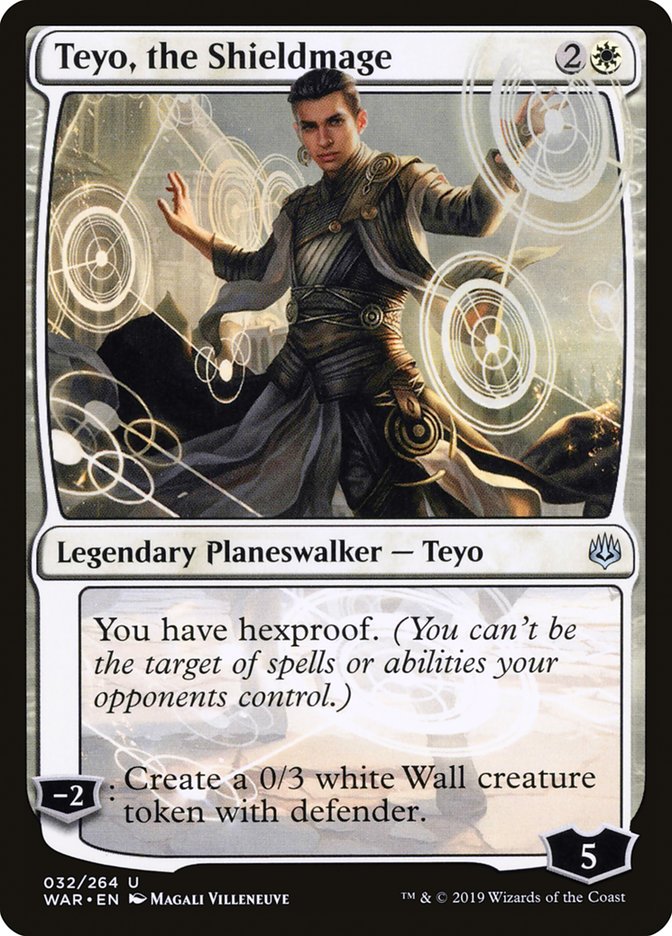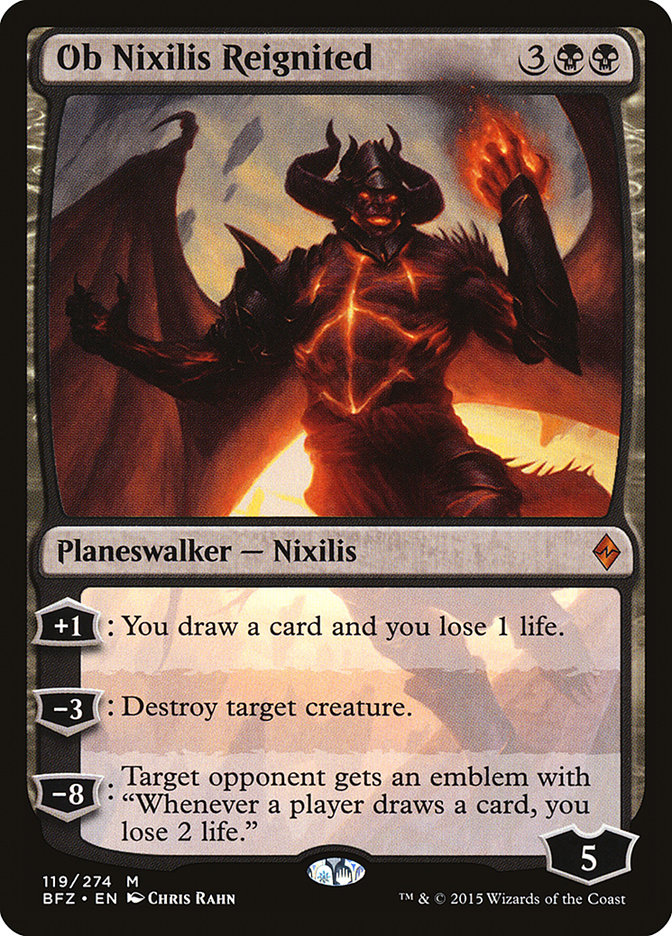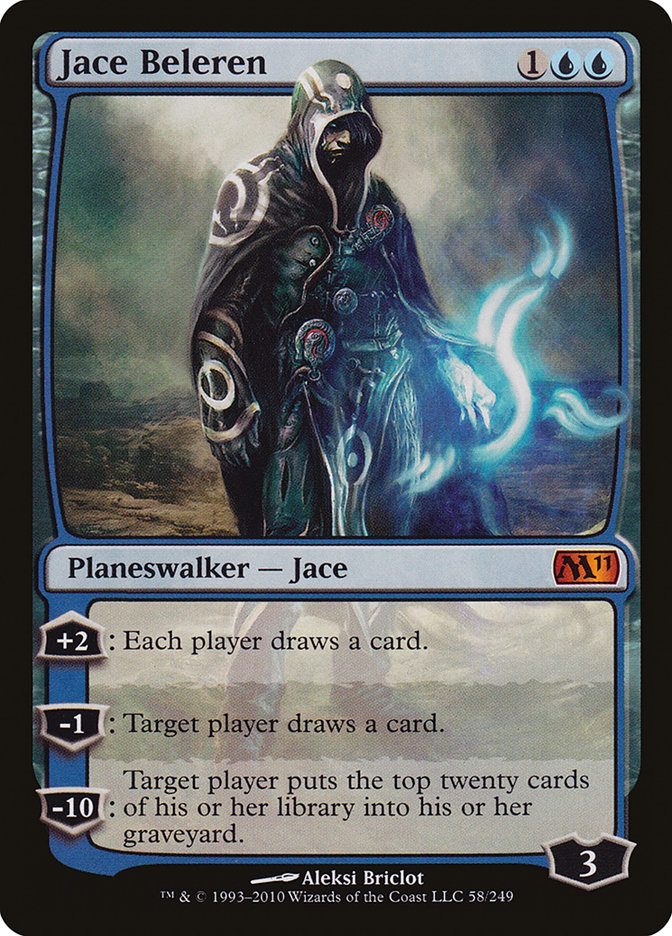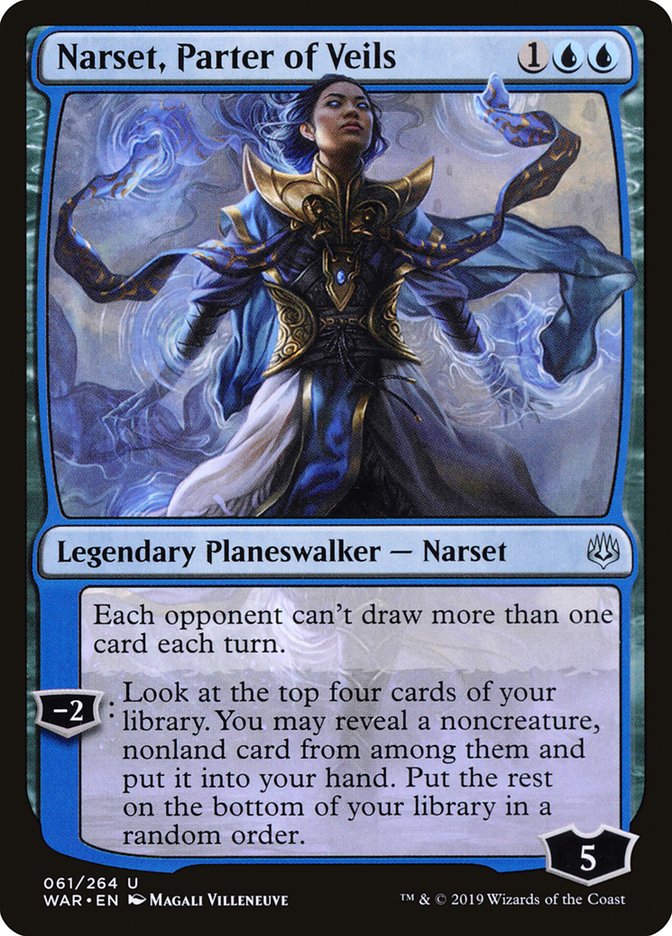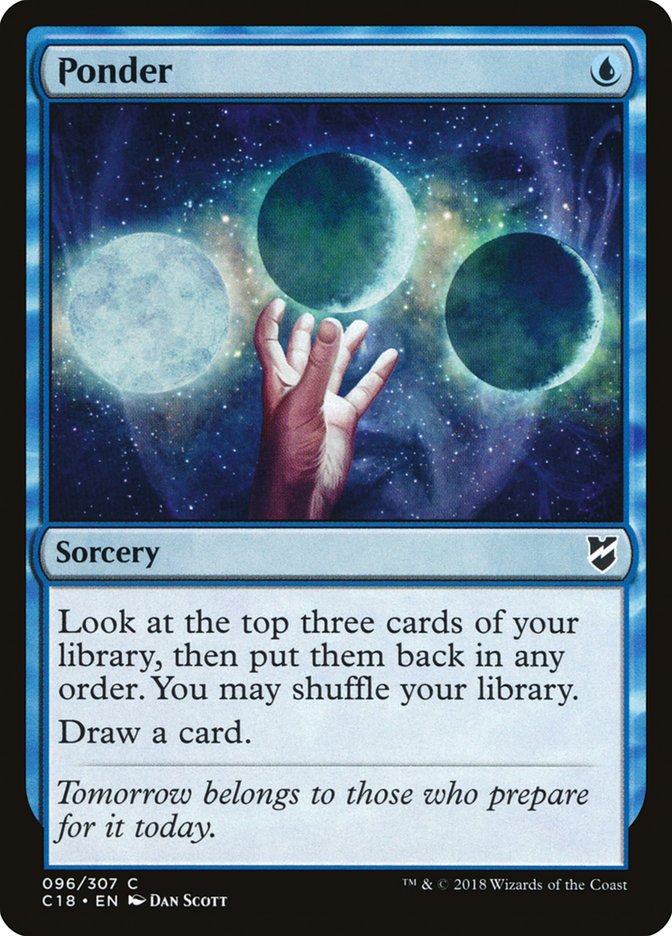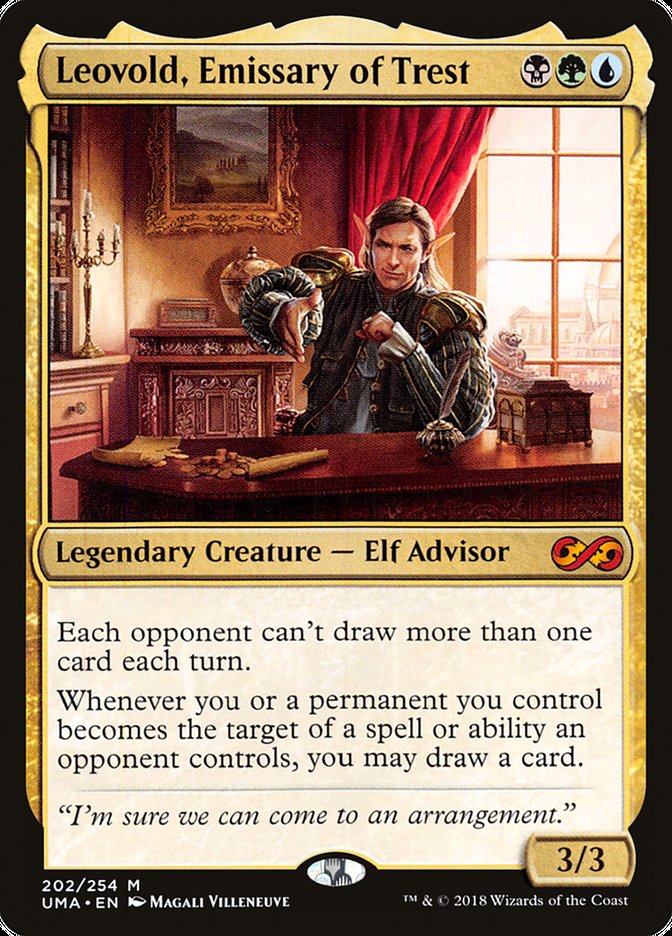Planeswalkers. How do they work?
When you take a step back and consider it without context, planeswalkers are weird. From a purely mechanical standpoint, they are essentially enchantments that sit around on the battlefield offering incremental advantages each turn, but with one key difference.
Planeswalkers get to be more powerful than equivalently costed enchantments because creatures can attack them. You can’t attack an Ivory Mask, but you can attack a Teyo, the Shieldmage. You can’t attack a Phyrexian Arena, but you can attack an Ob Nixilis Reignited. You can’t attack a Dictate of Kruphix, but you can attack a Jace Beleren. So these planeswalkers get to be cheaper, or offer an extra ability or two, compared to the corresponding Enchantments.
Every color has a built-in method of interacting with planeswalkers. “Just go f***ing kill them.” Enchantments and artifacts occasionally mandate narrower answers – things like Nature’s Claim or Disenchant – but planeswalkers can be pushed because any old aggro deck can just take a turn off to immediately kill the offending permanent without breaking a sweat. Sideboarding planeswalker destruction is simply not a ubiquitous consideration in deckbuilding, at least not to the same extent as sideboarding artifact or enchantment destruction.
Of course, as planeswalkers have become the major flavor mechanism for driving Magic’s story, the powers that be have decided that they merit a large place at the top of the metagame. To offer counterplay for all decks, not just aggro, answers in the vein of Hero’s Downfall, Vraska’s Contempt. Bedevil, Conclave Tribunal, Deputy of Detention, and Dreadbore have floated around as safety valves to check the power of these game-swinging machines. Wizards of the Coast has managed to figure out, through a bit of trial and error, how powerful they can realistically make planeswalkers and how flexible and cheap the appropriate answers need to be to balance them as important, but not all-important, components of Standard. But make no mistake, these are, by and large, Standard-power-level answers.
Standard is not the only format where planeswalkers have made an impact, though. In Modern, Jace, the Mind Sculptor; Teferi, Hero of Dominaria; Liliana of the Veil; Liliana, the Last Hope; and Karn Liberated have all won more than their fair share of games. And in Legacy, Jace, the Mind Sculptor is still the premier method for Miracles to close the door on games, as it has been for nearly a decade.
In older formats, a different paradigm still exists for how decks interact with planeswalkers, one that will become increasingly difficult to ignore with the influx of War of the Spark’s planeswalkers with static abilities. Chief among them, particularly for Legacy, is Narset, Parter of Veils. This is a card with potential for restructuring midrange blue-based decks in a way not seen since Deathrite Shaman left the format. This is a card that has hints of both Leovold, Emissary of Trest and Dig Through Time and inspires more than a little bit of brewing as we look for ways to maximize its power and minimize its weaknesses.
So how do we pinpoint a card like Narset as potentially playable in Legacy, specifically? Or any of the new planeswalkers, for that matter?
Planeswalkers, though they’ve been a part of Magic for twelve years, are still wet behind the ears in comparison to some of the foundational cards of the format. For the most part, they aren’t costed with Legacy in mind at all. And that’s a good thing. Legacy isn’t defined by combat and traction nearly as much as Modern, and way, way less than Standard. It’s come a long way, but for years, Legacy was barely defined by combat at all!
No, Legacy is a format defined by redundancy, efficiency, and consistency. Daze and Wasteland are the poster children for efficiency. If a card costs more than two mana, it had better be absolutely game-breaking. Jace, the Mind Sculptor and Sneak Attack are the most expensive Daze-able cards in the format, and both of those simply win the game if they stick. And before you ask, no, Palace Jailer doesn’t count because it is, for the most part, either in Aether Vial decks or sideboarded out against Daze decks, and Ad Nauseam is almost never cast into Daze without mana floating. And Eldrazi decks play Cavern of Souls.
That being said, three mana is a tall order in Legacy. Three mana is True-Name Nemesis. Three mana is Show and Tell. Three mana is Blood Moon. If it costs three mana, it had better be a pretty powerful card, and we simply don’t have that many three-mana planeswalkers. The best examples are Liliana of the Veil and Liliana, the Last Hope, both longtime contenders in the format. Does Narset, Parter of Veils make it to that crowd? A three-mana planeswalker with an effect that shuts down a whole class of cards might just make it over the invisible line that separates the playables from the laughables.
Brainstorm and Ponder are poster children for consistency, and they are the best in that class of potential future Narset victims. While spending mana to spin one’s wheels is never fun, these cards ensure that decks can keep wide ranges of hands, sift through their decks for the right answers or the right threats, and keep mana flood and mana screw safely at bay. Narset punishes decks that rely too heavily on their cantrip suites, turning a hand of “It could be anything!” into a hand of “None of these do anything!”
At the same time, Narset gives its controller two quick shots at powerful interactive spells on its own, with two built-in Azcanta, the Sunken Ruin activations to find Force of Will, Swords to Plowshares, or whatever else the situation may call for. Hampering enemy card selection while offering a powerful new source of advantage and selection itself, Narset plays both sides of the consistency war.
As for redundancy, well, Snapcaster Mage is sort of the poster child for that pillar of Legacy. With such a deep card pool, backup plans like Sneak Attack in Sneak and Show, Empty the Warrens in Storm, Snapcaster Mage in fair blue decks, Ancient Tomb / City of Traitors / Eldrazi Temple in Colorless Eldrazi, and Rishadan Port / Wasteland in Death and Taxes, Lands, and Goblins all exist to show that it’s not just single flagship cards that offer Legacy decks their power. Legacy has card clusters that underpin its pillars.
And yes, Narset offers a bit of redundancy here too, should folks decide to attempt to resurrect midrange Sultai decks with Leovold in the wake of Deathrite Shaman’s departure. But now, there are a ton of different options for a similar strategy, because unlike Leovold, Emissary of Trest, Narset only requires blue mana. Azorius Stoneblade has a way to dig for its best interactive pieces now, which may shift the balance away from True-Name Nemesis and back towards cards like Snapcaster Mage and Council’s Judgment. Dimir Death’s Shadow can employ this card in addition to its Lilianas as a way to fight a deteriorating Miracles matchup. Bant Noble Hierarch brews can try to leverage a mana advantage to plant a Narset before an opponent has time to use all their cantrips. Miracles finally has a secondary planeswalker, one that can dominate the mirror match and embarrass the erstwhile King of Miracles, Jace, the Mind Sculptor.
Focus here on the fact that these fair midrange decks get something “in addition to” their existing centerpieces. Narset provides redundancy via both powerful card selection and being a relatively expendable lightning rod for opponents’ limited planeswalker interaction. I’m excited to see how it fits into a format that has rarely had to contend with cheap, game-warping planeswalkers in general.
Some easy examples of where Narset will fit:
- Instead of Vendilion Clique, a common sideboard card to attempt to cover both combo and control matchups, Narset offers a pseudo-lock piece, shutting off Ponder and Brainstorm against decks that can’t possibly remove it while simultaneously finding extra copies of Force of Will, Flusterstorm, Daze, Spell Pierce, Thoughtseize, and the like. While Vendilion Clique offers a (relatively anemic) clock, Narset gives true card advantage via the double-Azacanta and shuts down twelve or more of the best cards in these combo decks. Oh, and it beats up on Miracles more effectively than Vendilion Clique and can’t be hit with Swords to Plowshares or Terminus, which is important.
- Sneak and Show decks themselves have occasionally employed a Jace, the Mind Sculptor or two to try to accelerate out against control decks, which can often be good enough for the win in and of itself (see: redundancy). Narset is cheaper (and therefore less Daze-able) than Jace, while digging deeply for protection spells, cantrips, Blood Moons, Sneak Attacks, or Show and Tells to set up for a midgame win. Turning off opposing Brainstorms and Ponders is the icing on the cake, forcing opponents to find an answer for Narset quickly or be unable to function.
- Narset is clearly not as good as Leovold against Wasteland / Rishadan Port decks. Leovold made it difficult to profitably harass an opponent’s mana with those cards, and cantripped when an opponent tried to destroy it. But Narset can’t be hit with Palace Jailer, and Narset “turns off” The Monarch. It’s by no means a good card against, say, Death and Taxes, but Palace Jailer was the key effect that let D&T compete with Miracles on raw card quantity into the late-game, and the ability to invalidate that effect is not to be sneezed at. And yes, Narset digs for Dread of Night. If you’re inclined to play that card in your Death’s Shadow decks, consider Narset as a tool to more consistently find it.
- Similarly, Narset digs for Surgical Extraction, Liliana’s Triumph, Blood Moon, Back to Basics, and more when it comes to properly fighting Lands. Surgical Extraction, in particular, is a key element to beating a number of niche Legacy decks, and any way to more consistently dig up that card is going to be desirable. I used to run Intuition in my old Esper Stoneblade decks as a “triple Lingering Souls” that could also be a three-mana Surgical Extraction when sideboarded in against Lands, a job that Narset also sort of accomplishes with significantly better residual effects. Increasing consistency when searching for bullets is universally desirable in Legacy, and Narset is going to offer blue decks a new tool to do just that.
Look. Standard has the proper balancing mechanisms for planeswalkers. It’s a creature combat format. Even the control decks all have Vraska’s Contempt. Narset won’t be format-warping in Standard, not unless something else goes seriously awry. Modern sort of has the natural balancing effects for a card like Narset, when you consider that most decks either go over the top of opposing planeswalkers (think Tron and Dredge) or can swarm them with ease (think Humans and Hardened Scales).
Legacy is different. Legacy has beautiful, mana-efficient answers like Lightning Bolt and Pyroblast, and counters like Daze, Spell Pierce and Force of Will, but many decks aren’t equipped to handle resolved planeswalkers without suffering card disadvantage, if at all. Narset, Parter of Veils is equipped to jump into that gap, with a floor of “Pay three mana to draw a card and then soak up three damage or a removal spell” and a ceiling of “Opponent’s deck turns off, you win.” That’s just good enough to move the needle on planeswalkers in Legacy, and I’m excited (and a bit overwhelmed) thinking about how it alters the landscape of the format.
Oh, and Vintage? If the London Mulligan doesn’t destroy the format under the weight of a thousand Bazaar of Baghdad activations, I wouldn’t be surprised to see Narset make waves in the format defined by broken spells, incredible card selection, and lots and lots of card draw. It’ll be a sight to behold.


